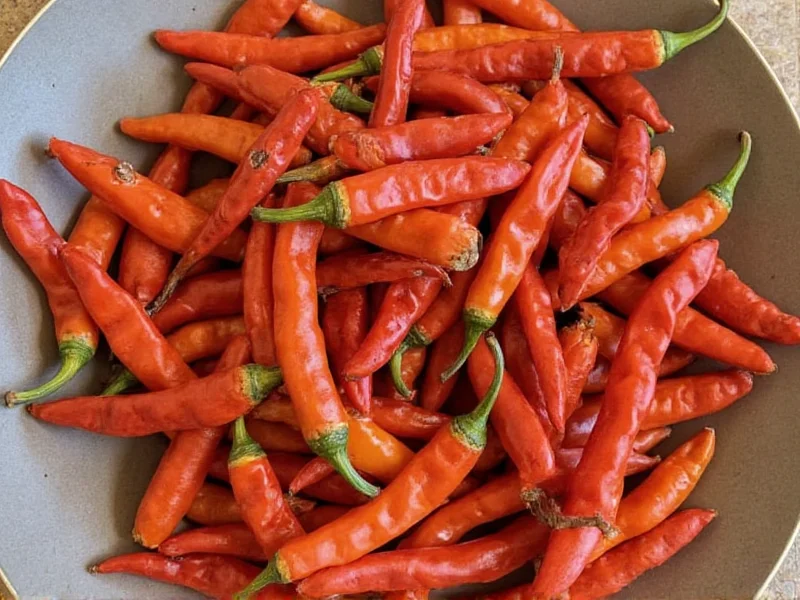Reconstituting dried peppers transforms shelf-stable ingredients into versatile cooking components that deliver intense flavor and authentic texture. This essential technique unlocks the full potential of dried chilies, making them suitable for sauces, soups, marinades, and traditional dishes that require fresh pepper consistency. Whether you're working with guajillo, ancho, chipotle, or arbol varieties, proper rehydration preserves their complex flavor profiles while restoring the plump texture needed for blending and cooking.
Why Reconstitute Dried Peppers?
Dried peppers concentrate flavor but lose moisture content, making direct use challenging in many recipes. Reconstitution serves three critical purposes: it softens the tough, brittle texture for easier handling and processing; it releases essential oils and compounds locked in the dried state; and it creates a consistent base for sauces and purees. Properly rehydrated peppers blend smoothly without gritty residue and integrate seamlessly into liquid-based dishes.
Four Effective Methods for Reconstituting Dried Peppers
While hot water soaking remains the most accessible technique, different culinary applications benefit from specific rehydration approaches. Each method affects flavor extraction, texture, and preparation time differently.
Hot Water Soaking (Standard Method)
The most reliable approach for general cooking applications involves submerging peppers in near-boiling water. Remove stems and shake out seeds, then arrange peppers in a single layer in a heatproof bowl. Pour water heated to 175-200°F over the peppers, using three cups of water for every cup of dried peppers by volume. Cover with a plate to keep peppers submerged and soak for 20-30 minutes until flexible but not mushy. Drain, reserving 1-2 tablespoons of soaking liquid for flavor enhancement in your recipe.
Cold Water Soaking (Gentle Flavor Preservation)
For delicate pepper varieties like pasilla or mulato where preserving nuanced flavors is critical, cold water soaking works best. Place cleaned peppers in room temperature water and refrigerate for 4-8 hours. This slower process extracts flavors more gradually, preventing bitterness that can develop with hot water methods. Check periodically and remove when peppers bend easily without cracking.
Steam Rehydration (Texture Preservation)
When maintaining structural integrity matters most—such as for stuffed pepper dishes—steaming provides superior results. Place peppers in a steamer basket over simmering water for 8-12 minutes until pliable. This method minimizes flavor leaching into water while restoring flexibility. Immediately transfer to an ice bath to stop cooking and preserve vibrant color.
Oven Method (Quick Alternative)
For time-sensitive situations, the oven method delivers faster results. Arrange cleaned peppers on a baking sheet, cover with foil, and bake at 300°F for 10-15 minutes while periodically spraying with water. Check every 5 minutes until peppers soften. This technique works best for small batches when immediate use is required.
| Reconstitution Method | Time Required | Best Pepper Types | Texture Result |
|---|---|---|---|
| Hot Water Soak | 20-30 minutes | Ancho, Guajillo, New Mexico | Uniformly soft, ideal for blending |
| Cold Water Soak | 4-8 hours | Pasilla, Mulato, Cascabel | Firm yet flexible, preserves structure |
| Steam Method | 8-12 minutes | Chipotle, Arbol, Serrano | Retains shape, minimal flavor loss |
| Oven Method | 10-15 minutes | Small batches of any variety | Slightly less uniform, quick solution |
Professional Tips for Perfect Reconstituted Peppers
Seasoned chefs employ several techniques to maximize flavor and texture when reconstituting dried peppers. Always inspect peppers before rehydration—discard any with mold or off odors. For enhanced flavor, add aromatics like garlic cloves, bay leaves, or a splash of vinegar to the soaking water. When preparing multiple pepper varieties for complex sauces, rehydrate each type separately to control flavor intensity. Never use boiling water directly on peppers as it can create bitterness; maintain water temperature below 200°F. After draining, gently squeeze peppers to remove excess moisture without losing valuable flavor compounds.
Common Reconstitution Mistakes to Avoid
Many home cooks encounter issues with rehydrated peppers due to preventable errors. Over-soaking causes peppers to become waterlogged and lose flavor intensity—monitor texture closely. Using insufficient water prevents even rehydration, leaving some areas brittle. Skipping the stem and seed removal before soaking creates bitter flavors and texture issues. Discarding all soaking liquid wastes valuable flavor compounds; reserve at least some for your recipe. Finally, attempting to reconstitute damaged or low-quality dried peppers yields poor results regardless of method.
Culinary Applications for Reconstituted Peppers
Properly rehydrated peppers serve as the foundation for numerous traditional dishes. Blend softened peppers with garlic, spices, and reserved soaking liquid to create authentic Mexican moles and adobos. Incorporate reconstituted chipotles into barbecue sauces for smoky depth. Use rehydrated guajillos in pozole broth for authentic flavor. For quick meal enhancements, slice reconstituted peppers and add to scrambled eggs, grain bowls, or roasted vegetable medleys. When substituting for fresh peppers in recipes, use a 3:1 ratio (three dried peppers replace one fresh pepper of similar variety).
Troubleshooting Rehydration Issues
If peppers remain stiff after standard soaking time, check water temperature—water that's too cool won't properly rehydrate peppers. For stubborn varieties, make small slits along the pepper's length to allow water penetration. When peppers become mushy, you've over-soaked them; reduce time by 5-10 minutes next batch. If flavor seems weak, try adding a pinch of salt to the soaking water to enhance extraction. For inconsistent results, ensure peppers come from a reputable source—older stock rehydrates poorly regardless of technique.
Storage of Reconstituted Peppers
Use rehydrated peppers immediately for best flavor, but you can store them properly for later use. Place in an airtight container with just enough soaking liquid to cover, and refrigerate for up to 5 days. For longer storage, freeze peppers flat on a parchment-lined tray, then transfer to freezer bags with 2 tablespoons of soaking liquid per cup of peppers. Properly frozen reconstituted peppers maintain quality for 3-4 months. Never refreeze previously frozen rehydrated peppers.











 浙公网安备
33010002000092号
浙公网安备
33010002000092号 浙B2-20120091-4
浙B2-20120091-4